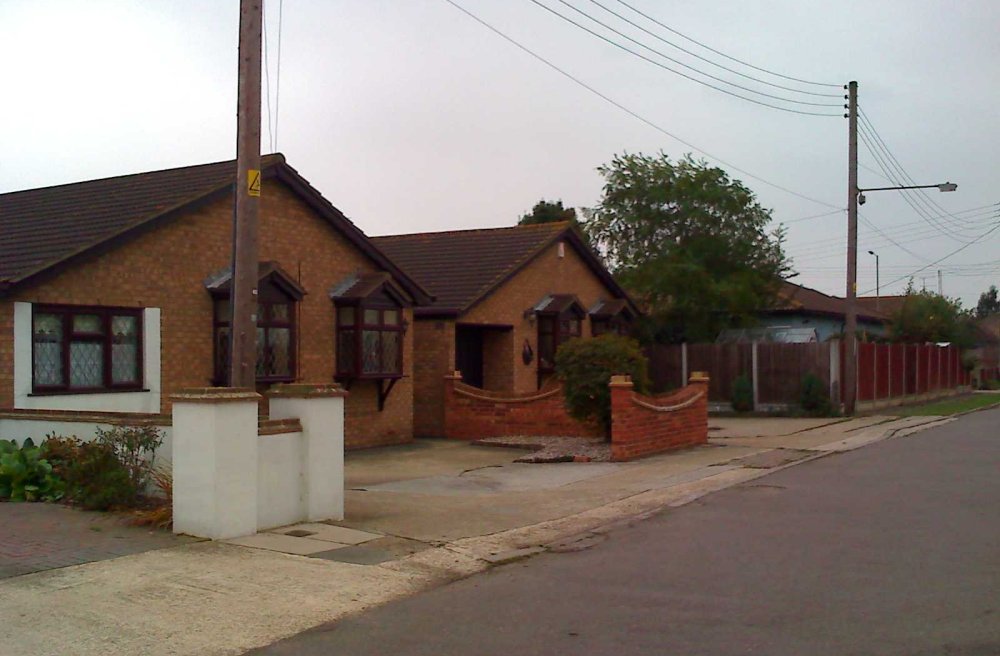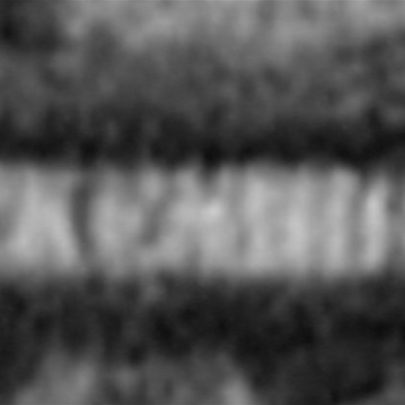'Atomic Bomb Proof' Bungalows
Miramar Avenue/Long Road
This picture was sent in by Frank Whitnall. His son Simon found it while browsing at the Battlebridge car meet. It is inscribed:
‘Jim, Kit, Reg and Olive. Mirama Avenue, Canvey Island’
Miramar Avenue (at right angles to Long Road) is part of a small estate of so-called ‘Atomic Bomb Proof’ Bungalows built shortly after WWII and this photo appears to have been taken in the late 50’s. The name on the gate belonging to another pair of bungalows, just out of view, is ‘Brockenhurst’. (see enlargements in the gallery below)
Does anyone know who ‘Jim, Kit, Reg and Olive’ were?

‘Jim, Kit, Reg and Olive. Mirama Avenue, Canvey Island’
The following picture was taken at the same location in Miramar Avenue in 2009. As you can see one of the pair of bungalows in the picture above has been demolished and two new ones have been built. The furthest bungalow on the right (painted blue) on the corner of Long road is one of the original bungalows but with an apex roof.

The next picture is of the four pairs of the bungalows in Long Road and the last picture is as they are today.

Four pairs of the ‘Atomic Bomb Proof’ Bungalows that fronted on Long Road

Same four pairs of ‘Atomic Bomb Proof’ Bungalows, now three pairs with apex roofs and one with first floor added
The pair of bungalows where the name on the gate was ‘Brockenhurst’ can be seen in the gallery below as it is in 2009. The only other bungalow still in its original state is in Long Road and can also be seen in the gallery below.
Quite why the buildings were called ‘Atomic Bomb Proof’ we do not know, if anyone has anymore information on the construction or how they come to be known as such, please make a comment below.
Update see plans of bungalow here








Comments about this page
I remember these houses being built in the late 1940’s,I was a pupil at Canvey County Primary school (opposite) at the time.We used to call them “The Atomic houses” and I believe the name arose from what we thought they looked like taking into account the mind of a ten year old influenced by the then perception of how people could be protected from an atom bomb!
Interestingly they were built that way purely because that was how they were designed- they must have been among the last houses to be built without a cavity wall as most if not all of them were adapted to incorporate a cavity wall in later years -but they were never bomb proof!
Hi Ian
Thanks for the comment and info on the construction of these bungalows.
Graham
I used to live in one of the ‘Atomic Bomb Proof’ bungalows. I moved there in c1960, the buildings were then 15years old. Ours cost £1500 at that time and was called ‘La Maison’. They were definitely ‘Atomic Bomb Proof’, this is how they were advertised and the walls were so hard…………..
Despite the recent article in the new ‘Love Canvey’ publication there is no proof that these bungalows are anything to do with the American ‘Atomic Ranch’ Style. Also any comments in the article have no connection with the Archive.
My grandparents (Smith) lived in the second bungalow along from the Eastern end of the row facing Long Road. We called it ‘the bombshell bungalow’. It had been named ‘Journey’s End’. They moved in about 1947/8 and lived there for about 10 years. As children living in Ilford, we always spent part of the summer holidays there, arriving by steam train from Barking station. I remember climbing up onto the roof with my Grandmother with a bucket of mortar to fix cracks in the roof, which seems to have been finished only with a sand and cement screed. Small wonder that later occupants ditched the flat roof for a pitched roof. The flat roof came into its own in the flood of 1953. Our grandparents spent the night up there while water swirled around their door. I remember the relief we all felt on learning that they were safe.
Does anybody else remember the builder’s sign outside these houses, saying something like “New bungalows, proof against the atomic bomb” ?
Seems a pity one of them has not been listed.
Michael Swanson
I remember my Father who was a builder and decorator saying that the postwar government set maximum prices for new homes and the only way that it was possible to build homes was to build them down to the price and to cut every corner possible, hence no proper roof.
We live in the first one in the Eastern side that is now a two storey house. We had to take up floor boards last year to fix some pipe work and there’s still the screed and shingle from the old roof.
My understanding is that flat roofs and solid ground floors were usually mandated for new build houses in the postwar austerity era to reduce the need for (imported) timber, as together they accounted for around 50% of the timber required to build a house. However, flat roofs were used for some pre-war houses as a matter of aesthetic design: there are quite a few what were obviously expensive-when-built, 1930’s flat roofed houses locally, although some have had pitched roofs added subsequently.
Add a comment about this page